Do the Pilgrims Still Matter?
The 400th anniversary of the Mayflower’s landing finds Plimoth Plantation—and all Americans—wrestling with a complicated history.
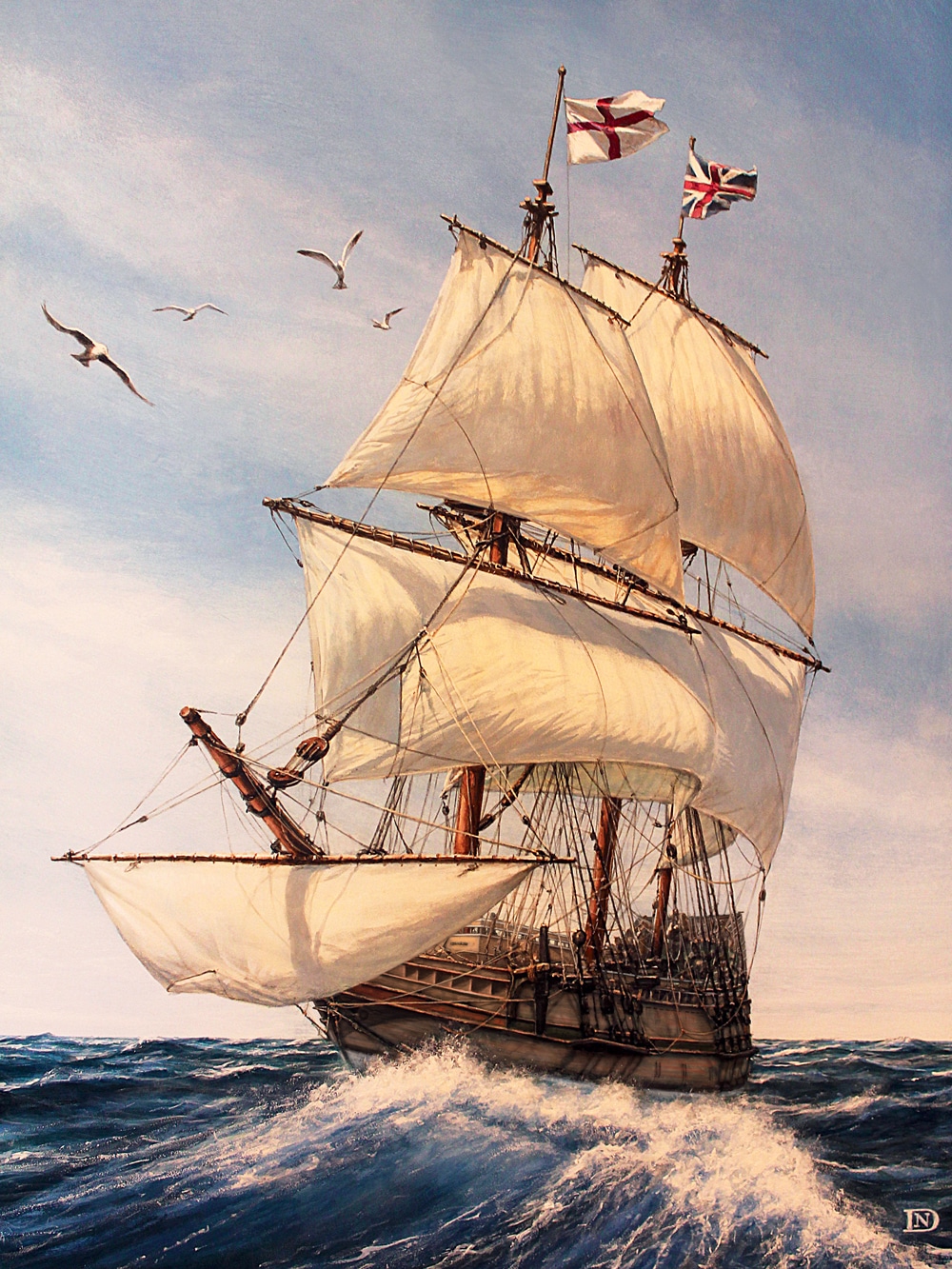
Coffee By Design | Portland, Maine
Photo Credit : Katherine KeenanEditor’s note: The living history museum known as Plimoth Plantation for more than 70 years announced this summer it would change its name to reflect its commitment to telling both the English and Native American stories equally. Shortly before press time, the new name was confirmed as Plimoth Patuxet Museums. Patuxet is the Wampanoag name for the Plymouth area.

Photo Credit : Peter J. Carroll/AP Images
The Mayflower sits calmly at anchor, its sails furled after a long voyage. Around it, a crush of smaller boats fills Plymouth Harbor, jockeying for position, vying to be the closest. The photograph is old and grainy, but it’s clear what’s happening on the shoreline. Thousands of people stand at the water’s edge, pressed cheek to jowl, shouting, cheering, celebrating.
“This is the scene we want to re-create,” Kate Sheehan tells me.
She takes the photo from my hand and places it atop the small mountain of promotional materials that is threatening to snap her desk in two. We are at Plimoth Plantation in Plymouth, Massachusetts, where as the associate marketing director Kate has spent the past several years preparing for 2020, the 400th anniversary of the Pilgrim landing. The highlight of the museum’s celebrations will be the return of its Mayflower replica from a restoration stint at Mystic Seaport in Connecticut. Kate wants the crowd to be no less than the 25,000 who greeted the ship when it first sailed into the harbor, in 1957.
This is before, of course.
It’s March 4, and as Kate guides me through the museum’s visitor center, I can’t help but question whether people will really show up for the Pilgrims in 2020. As American icons, the Pilgrims have lost much of their shine over the past several decades. The days of elementary school pageants—with half the kids in buckle hats and the others in feather headdresses—are mostly over. The Pilgrims’ story once bound the country together; now it is a source of division. If 25,000 people turn out for the Mayflower, I wonder, how many will be there to protest?
The building is buzzing with activity as the staff prepares for its spring opening. Workers are painting the walls in those muted colors we’ve come to think of as “colonial.” In the gallery, curators are putting the finishing touches on an exhibit highlighting the findings of a new archeological dig in town. And in a large hall, the museum’s army of interpreters are gathered for their spring conference, a series of lectures and workshops where they hone their peculiar craft.
Plimoth Plantation is a living history museum. Its grounds are dominated by an authentic re-creation of Plymouth as it would have looked in 1627. Each of the “Pilgrims” you find there is an interpreter role-playing an actual historical figure. From 9 to 5 they live and breathe the 17th century. They will talk your ear off about what life was like in Holland, the rottenness of the Church of England, or the temperament of their rare-breed sheep, but they will not break character, no matter how many times you ask to take a selfie with them.
I slip into the back row and listen to a delightfully madcap workshop titled “Accent Your Accent.” Joshua Bernard, the museum’s resident linguist, is pleading with his coworkers to erase the present progressive tense from their minds. Tacking -ing to the end of a verb simply wasn’t done in the early 17th century. The Pilgrims never would have found themselves walking to the market. “You shall to the market go!” he implores.
He brings up two young interpreters, a woman and a man, and has them act through a scene, improv comedy–style. Deal with a crying baby, he instructs. “That baby … ought not cry in my presence,” the man stammers. “The baby to God should cry out his praise!” the woman replies.
The crowd laughs. To the kinds of history buffs who role-play Pilgrims for a living, this is comedy gold. Still, beneath the levity, there’s an undercurrent of stress among the staff. This year is going to be different. It’s going to be bigger and more intense.
Even in a normal year, the history they teach is a lightning rod. The 400th anniversary will draw only more scrutiny. To some people the Pilgrims represent American ruggedness, religious freedom, and democracy; to others they represent colonialism, white supremacy, and the genocide of Native Americans. In truth, they were a little bit of all of these things, but complex stories do not hold up well in a culture war. The Pilgrims are no longer just historical figures, they’re symbols—and a symbol must stand for something.
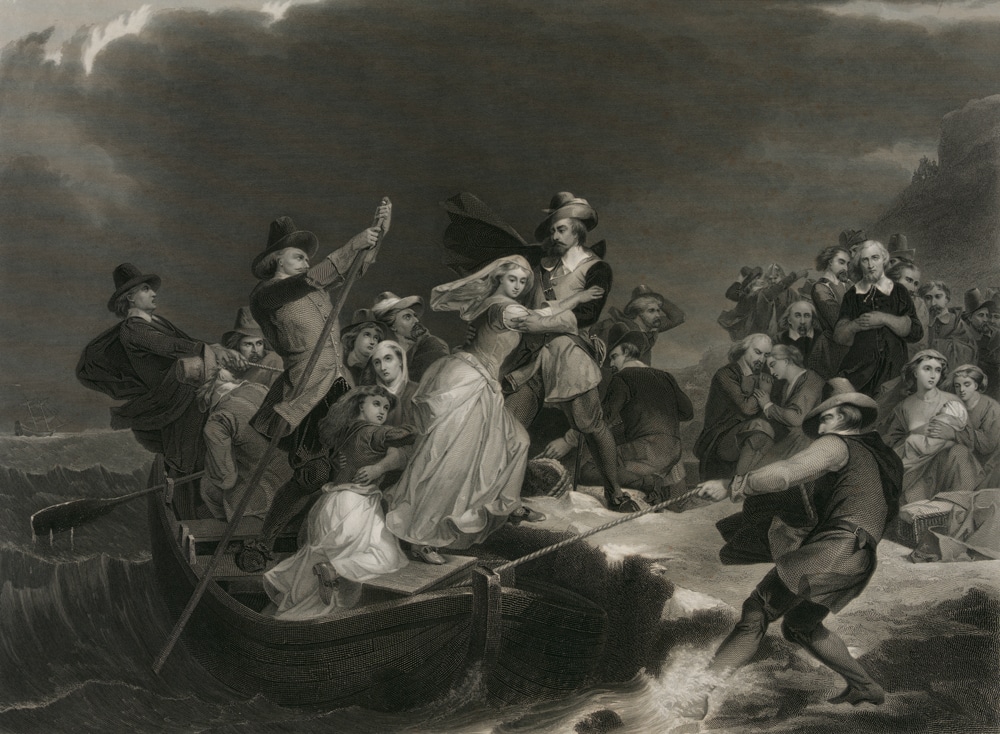
Photo Credit : Library of Congress - Prints & Photographs Division
The museum does its best to stay above the fray. The interpreters take a just-the-facts-ma’am approach to history and avoid editorializing. Plimoth Plantation is more than happy to tell you what the Pilgrims were like, but it lets you make up your own mind about what the Pilgrims mean.
This approach sets the museum up as a kind of Pilgrim Switzerland—not neutral, per se, but noncombatant. That said, when you’re dressed from head to toe as a 17th-century Puritan separatist, you’re going to draw some fire.
After the workshop, I catch up with Joshua and ask him how he’s feeling about the coming year. “It hits me in waves,” he says. Still, he’s mostly excited. He believes what they do at the museum is important, and he’s been interpreting for so long he knows how to get through a tough conversation.
“Stand firm when people try to reject history around you,” he says, “but also allow yourself to be enough of the bad guy to show that [the Pilgrims] also were not perfect.”
At the end of the day, Kate Sheehan guides me back to the front of the visitor center. She mentions in passing that she has to get to a meeting to discuss what the museum will do if this weird virus somehow gets here from Italy. She doesn’t seem that concerned.
Ten days later, on March 14, Plimoth Plantation opens for its 400th anniversary season. The very next day, the museum shuts back down—along with basically everything else.
* * * * *
Even without the coronavirus, the 400th anniversary never stood a chance of topping the 300th. America greeted that date with a level of spectacle that would put a Super Bowl to shame. The town of Plymouth hosted a pageant featuring nearly 1,400 actors; the country’s most famous composers provided the music and Robert Frost contributed to the script, which set the Pilgrims at the heart of an epic that transcended time. Among the cast were a group of Vikings, Sieur de Champlain, and Abraham Lincoln. Plymouth Rock itself even got a speaking role. “As one candle may light a thousand so the light here kindled hath shone to many, yea, in some sort to our whole nation,” the rock bellowed.
Across the country, politicians of every stripe offered up their praise. Massachusetts governor and soon-to-be-president Calvin Coolidge gave a speech in which he immodestly declared that the Pilgrims had not, in fact, sailed from England: “They sailed up out of the infinite.” He then equated the Pilgrims with the very notion of religious freedom and carved out a place for them in the broader Christian cosmology, as though the long road from Genesis to Revelations runs squarely through Plymouth Harbor.
“Civilization has made of their landing place a shrine,” Coolidge said. “Unto the Commonwealth of Massachusetts has been entrusted the keeping of that shrine.” He argued, essentially, that remembering the Pilgrims was a sacred duty.
One hundred years later, a very different governor of Massachusetts declared it legally “nonessential.”
The museum shut its doors, and I shut mine. From quarantine, I tried to keep tabs on the anniversary online, but few people outside Plymouth were talking about it. History 400 years in the making will always lose out to history being written right this moment. No one seemed to have an appetite for debating what the Pilgrims mean to America today. The expected wave of newspaper op-eds decrying or defending the Pilgrims went unwritten and unmissed. I began to wonder if arguing about the past is a luxury of people not struggling to survive the present.
In the early days of the pandemic, the museum’s website struck a defiantly optimistic tone, continuing to sell tickets to tour the Mayflower upon its return in May. Then a news release quietly appeared announcing the furlough of most of the staff. Next the museum began soliciting donations to help make up for lost visitor revenue in a post distressingly titled “We’ll Be History Without You.”
Plymouth 400, the organization planning the celebrations in town, canceled its events through September. A smaller event that had been planned to celebrate the Mayflower’s visit to Boston in May was also scrapped. In their press release, organizers teased that the Mayflower might still be towed into Plymouth Harbor on schedule Memorial Day weekend.
Could that be true? I wondered. Would they really sneak the ship back when no one was looking? It would be a massive disappointment for the museum, but I couldn’t help but think that it would also be the most historically accurate way to do it. After all, when the original ship arrived in 1620, there was no one on shore to witness it. The only eyes present belonged to those on board, and they were undoubtedly looking west toward an unfamiliar land and an uncertain future.

Photo Credit : Dan Nance (dannance.com)
It’s a fair bet that on that day, not one of them speculated about how they’d be remembered centuries later. They were Calvinists—humble people who viewed the world as just a prelude to the infinite. When they thought of the future, they thought of their afterlife, not of their earthly posterity. If any of them could have seen that 300th anniversary gala, they probably would have condemned the spectacle as garish idolatry.
That’s the thing about making heroes out of historical figures: It’s rarely about them or what they would have wanted. We do this for ourselves. Humans have always had a weakness for heroic origin stories. They make us feel as if we’re inheritors of some great tradition. They also make the past seem simpler and more intentional. Ideally, we’d like the past to be like a tree—a great, linear trunk branching into innumerable stories, each connected and dependent upon that one perfect seed from which it all sprang.
But that’s a fantasy. The forces that shape the world are bigger than individuals, bigger than single moments. History isn’t a tree, it’s a meadow. It’s a million individual threads twining and unraveling in the wind. When you’re in the midst of it, it’s chaos. It’s only from a great distance that you can discern the shape of it—and fool yourself into believing that it is one single, coherent thing.
If the Mayflower had sunk in the North Atlantic, New England still would have been colonized. Native Americans still would have been killed or displaced. Democracy, religious freedom, revolution—none of these things were dependent on 100 soggy settlers stumbling onshore one chilly day in 1620.
Yet just because they weren’t the cause of these things, it doesn’t mean there’s no value in their story. It doesn’t mean we can’t learn something or feel some connection. In fact, during the darkest days of the pandemic, as I compulsively reloaded news websites and fretted with my sister about our parents’ safety, I understood the Pilgrims better than I ever had before. I could see them now not as heroes, not as founders, but as a confused bunch of people who, like me, were scared, focused on the present, and completely unable to predict what their lives would look like a year in the future.
They were then as we are now—lost in the weeds of a history that had yet to be written.
* * * * *
On Memorial Day weekend, no sails were spotted approaching Plymouth Harbor. News of the ship’s clandestine return proved to be just a rumor. The museum still hoped for a grand homecoming; it just wasn’t sure about when or how.
Plimoth Plantation opened its doors to the public on June 11, well ahead of most other museums. It had slipped into phase two of the Massachusetts reopening plan by arguing that as an open-air museum it functioned more like a botanical garden, and in those first days that seemed like an accurate description. During the quiet months, nature had taken steps toward reclaiming the land. The birds had returned in a number and variety that interpreters had never seen, and emboldened turtles had made nests across the grounds.
Visitors on opening day experienced a changed museum. Most interior spaces were barred to them (social distancing inside a thatched-roof cottage just isn’t feasible). Visitors could no longer roam the grounds freely, but were instead bound to a fixed path that minimized the chance of groups running into each other. Most notably, the Pilgrim village that the museum had spent so much effort making historically accurate was now littered with anachronisms: public safety signs, hand sanitizer stations, and, of course, masks.

Photo Credit : Christian Kozowyk
Kerri Helme, a veteran Wampanoag interpreter, is making the most of the new uniform requirements. She wears masks printed with squash blossoms and other native designs so they don’t clash so badly with her traditional deerskin clothing.
She works at the Wampanoag Homesite, a space set apart from the village. Unlike her Pilgrim coworkers, she is not in character. She never thinks twice about the present progressive tense, greeting visitors in plain English with a noticeable Boston accent.
Kerri and the other native interpreters aren’t bound to the year 1627. They wear the clothing their ancestors would have worn and they demonstrate traditional skills, but they’ll talk to you about anything. King Philip’s War, forced Christianization, the federal government’s ongoing attempts to strip away their Mashpee reservation—it’s all on the table and they genuinely want you to ask.
I ask her if those conversations are coming easier now, and she says they are. “I’m having a lot longer and more meaningful interactions with visitors,” she says. “I think people are seeking that more.”
While the museum was closed, the country changed in more ways than one. The killing of George Floyd sparked a national reassessment of our history. Protestors pulled statues from their pedestals. Whatever historical pause we experienced at the beginning of this crisis is over. Americans definitely want to argue about the past, and it’s only a matter of time before the Pilgrims have their moment.
But this isn’t all new. Kerri has worked at Plimoth Plantation for well over a decade, and she’s seen this change coming. People have become more informed about the history and more eager to hear the native perspective. Sometimes visitors come to her bragging that they just told off a Pilgrim. “And I think, Oh my gosh, the person they’re yelling at is such an ally to the Wampanoag people,” she says.
What the public doesn’t understand, Kerri says, is that she wants this story to be told. She wants you to see the whole picture. “This is the environment that our ancestors lived in,” she says. “We had allies, just like we do now, and we had enemies, a lot of enemies, too. We don’t want to play into painting a picture of it being some blissful situation here.”
This is the kind of history Plimoth Plantation likes to do. It shows you what the past was like, with all the warts and contradictions, and then, if you want, it gives you a chance to unpack it all.
This is what good history is. It’s what sets a museum apart from a monument. It acknowledges that historical figures, when they were alive, were just as flawed as we are today. More important, it acknowledges that historical figures are, in fact, dead. None of the praise or condemnation leveled at them ever reaches their ears. They don’t know, and they don’t care. All that’s left on this earth of the Pilgrims and everyone else from 1620 is the lingering consequences of their actions, both good and bad. We all feel them, whether we’re aware of them or not. The only way to understand the legacy of the past is to let go of the myths and the heroes and the simple stories and look bravely at the whole big ugly mess.
After the opening, I caught up with Richard Pickering, the deputy director of the museum, and asked if, after everything that had happened, the museum had adjusted its interpretation at all. He said no. The message is what it is, but he wonders if people will be more receptive to it now. “I think the experience we’ve had as Americans, seeing people either reach incredible heights of kindness, as was seen in Plymouth, or perform incredible acts of coldness, as was seen in Plymouth, we will now be able to understand the past better because of the tapestry of what we’ve been seeing over the last couple of months,” he says.
It’s an interesting thought. Will living through a tragic and divisive time make us more receptive to talking about tragic and divisive history? Maybe, but I think we have a long way to go. People may be toppling statues, but I don’t think we’re ready to topple the very idea of statues itself. I’m sure we’ll continue to divide history into heroes and villains. I’m sure we’ll continue in vain to balance truths atop pedestals. I’m sure we’ll continue to turn people into symbols and then argue about what those symbols mean.
When they see the Mayflower today, back at its berth once more, I think most people will still feel as though they have a binary choice, to either cheer for it or curse it. But I hope some will find a space in the middle. I hope some will come to see it not as a monument, not as a symbol, but as a frank acknowledgment of what happened and an invitation to have a long, painful, and honest conversation about everything that happened next.
Sidebar: The Return of the Mayflower
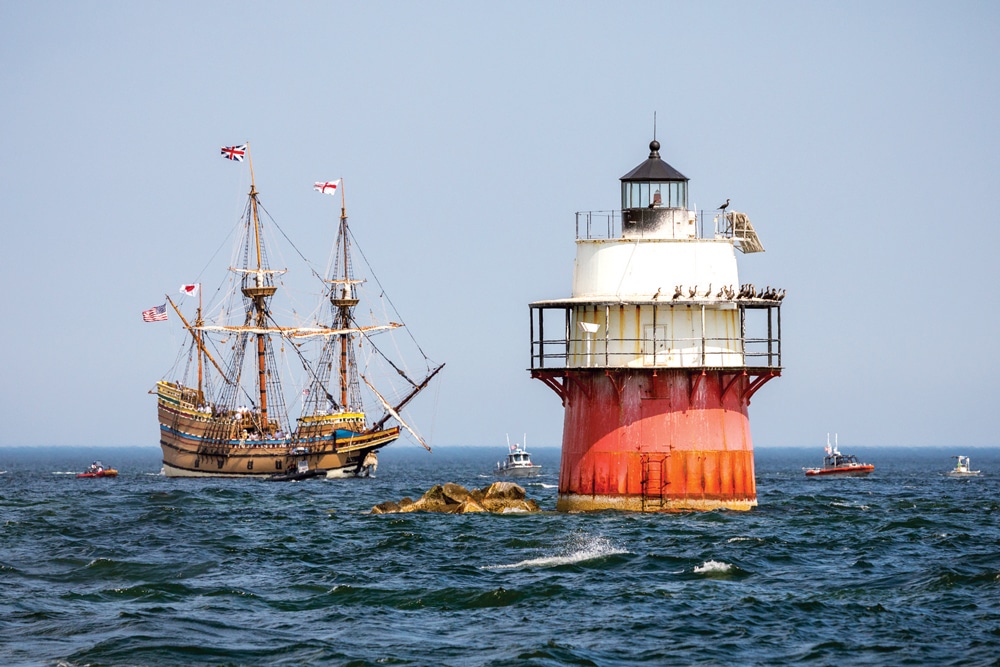
Photo Credit : Courtesy of Plimoth Plantation
Greeted by hundreds of watercraft and more than 1,000 people on shore, the 64-year-old tall ship Mayflower II sailed back into Plymouth Harbor on August 10. For a glimpse into the three-year, multimillion-dollar restoration that preceded the ship’s return, look for Weekends with Yankee’s visit to Mystic Seaport in season 4 (episode 7, “Handmade in New England”). At the preservation shipyard there, we take a tour of the Mayflower and talk with Plimoth Plantation’s Whit Perry, who led the project that saw nearly 70 percent of the ship’s timbers, planking, structural frames, knees, and beams replaced. For more information and to find out how to watch the series, go to weekendswithyankee.com.




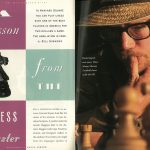
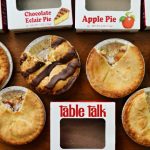
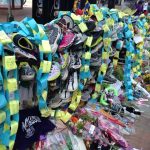

The Pilgrims matter. It happened. People can just grow up and live with that. Or not live with it. Whatever choice they make, history will be what history is. Facts are truthful, and the truth of the facts will never change to suit feelings. If they’re offended, then let them remember to be sure and NOT take Thanksgiving Day off and to get out of my way at the Supermarket when I’m buying the food for my family’s God-Fearing Thanksgiving meal. Oh you’re welcome, people that I just offended.
I do believe that the Pilgrims matter, not because I’m descended from 7 of the Pilgrims/Separatists, but because they set in motion tolerance and freedom that we pride ourselves on to this day. Religious freedom was at the basis of their coming here. Everyone should be able to have their opinion and their voice to be heard and if someone’s view is different than yours, so be it. America, remember is the Land of the Free. Thanksgiving is most American’s favorite day/holiday. Without the Pilgrims, you do not have Thanksgiving. And more so can be said that without the Tribe that aided in our Pilgrims to survive, was the Wampanoag tribe. Without them, we would have no Thanksgiving or Pilgrims and our lives would probably be a lot different. Giving thanks, not just to one race, but several races is what we give thanks for. Being thankful that we can voice our differences and what matters to one person, may not matter to me, but I’ll still accept their opinion and try to respect them. Wishing you all a very Pilgrim-like and kind Thanksgiving!
The Pilgrims had no evil intent whatsoever, and their main purpose was not imperialism, colonization, or even trade or money-making business; these were simply necessary by-products of their mission, which was to establish a community where they could live in peace according to their belief in godliness. A few “Strangers” on the boat were opportunists, along for the adventure. Most of that first generation had positive relationships with the Natives, even Winslow treating a deathly ill Massasoit at one point, likely saving his life. There was an earned and growing supportive and trusting relationship between the Pilgrims and Natives in that first generation. The Thanksgiving feast honors and commemorates that. The mistrust and tension accelerated in the subsequent generations of both the settlers and the Natives, leading to the tragic losses of King Philip’s War. Still, there were people on both sides who advocated for peace and cooperation, in the midst of the turmoil. We can learn from their example.
I am moved by this article. Bringing to attention. Not to idolize or demonize historians but to humanize them. Know that we are all flawed and to honor the achievements and learn from the dark errors, making right as we move forward.
Gratitude is something I try to practice especially the entire month of November.
Plymouth and Thanksgiving is a very important part of our history and the
Courageousness of the Pilgrims immigrating to find the freedoms we cherish
now today I am Grateful for everyday. Most of Our Ancestors except Native Americans didn’t just appear here. We are a melting pot especially in New England as well as across the country. I hope to help celebrate Thanksgiving
and the 400th in Plymouth when it safe. Happy Thanksgiving To All!
Great article, thank you! Rare impartiality, good questions. We really need to embrace it all.
The Pilgrim matters. They Voyage across the Ocean , a dangerous mission, to Escape British Crown Taxation.
They wanted to Colonize and not be dictated by The
Church of England but Freedom to Worship as they
Choose. They endangered their lives to live in unknown
And uncharted wilderness, often killed or injured by wild
Animals or Savages. Ect.. They then friended the Savages to
Civilize and Teach them English ect.. They had to risk disease
Too. Pilgrims matter.
You can not change history.
I worked at Plimoth Plantation in the Development Office and could go down to the village during lunch in be in the 1620s. Plimoth Plantation is the best, most historically accurant museum of it’s kind. AND< I did work with Richard Pickering. A wonderful time in my life! SRM
Thank you for this wonderful article. Beginning in the Summer of 1964 I worked abroad the Mayflower II as a guide. This was to become my summer job for many wonderful years. In fact I still have one of the required reading books that was issued to use during our initial training at the Plantation. Back in those day we were required to wear the traditional dress that the crew would have worn. As I recall we rotated positions every hour. I also recall the chilly days of November when the sip was open through Thanksgiving. I now live outside of Seattle, however my wife and I visited Plymouth in September 2019 and noticed all of the preparations work being done to welcome Mayflower II back to her home…. which not unlike the first voyage, didn’t go according to plan due to covid. I cherished those times working abroad Mayflower II and I look forward to visiting her once this pandemic is over. Brighter days are just over the horizon. Happy Thanksgiving!
The book ‘Mayflower’ is a great story about the coming of the Pilgrims to America. Should be read by everyone.
I get tired of the judgment of other peoples and other times. I think our nation will also be judged for this Trump era, and rightfully so. Different circumstances make for different choices and different options. Yes, it would have been MUCH MORE ADVANTAGEOUS if white people had treated all peoples in the world with fairness and equity. But we can’t change the historical wrongs, WE CAN ONLY CHOOSE FAIRNESS IN THE PRESENT AND SET UP AN EXAMPLE OF PRIORITY FOR FAIRNESS AND EQUALITY FOR ALL FOR FUTURE GENERATIONS .
One of the worst articles ever written here. I want my time back that I just spent! Really confused why he wrote this. Virus from Italy? He wastes time with obscure metaphors if history is more like a tree or meadow…what? Mentions Genesis to Revelations, look Justin, if you don’t know what you are talking about then don’t talk about it. The last book of the bible, which I assume you are referencing is Revelation, not Revelations! Sadly you feel lost in weeds of history were I enjoy being anchored by the love of an eternal and forgiving God.
My goodness, if this tepid article unleashed such a reaction in you then you’re more of a “snowflake” than I am!
If some had a choice and it seems they are winning, we would wipe out all history. I’m sorry great things happened in this world and some really horrible things also happened. That is called history. When I do genealogy and someone in my family did bad things do I wipe them out, no it happened and we can’t change it but only try to do better going forward.
Amen, Christine. Some people cannot accept reality. The Pilgrims are a huge part of our history. Only a fool would say they didn’t matter.
Thank you for writing an honest account of the Mayflower and reminding us that very few historical figures are villains or heroes. They are both. None of us are or were perfect. The demonization of history, and the need to rewrite it to fit a narrative, will be the undoing of some. Because if we don’t remember our history, good and bad, we will repeat it. Happy Thanksgiving and thank you again for your article!
I really enjoyed reading this article. To visit Plimoth Plantation has been on my travel list for years. As with others, the pandemic has put all travel plans on hold. I’m a retired teacher and LOVED teaching about the Pilgrims to my 3rd graders. Never spoke much about the conflict between the Native Americans and Pilgrims, just the comradery and “coming together” of both cultures. Thanks for this good article.
I enjoyed the article, but wonder if others are seeing the irony of canceling the 400th celebration because of a coronovirus. The pilgrims knowingly risked their lives to gain freedom, yet we are told that because we might get sick we have to stay in our homes and be afraid to breathe the fresh air. We can do everyday things like go to the grocery store, but yet there cannot be a celebration of an event that in reality made us being here happen.
Although, i have a sounding popular North American name, I am- originally- a Dominican Republic’s native. So I’d like assume my reading is as somehow influence. And it’s kind of refreshing to see this difficult subject interpreted, well. Here’s “the official story” and “the others stories” – are questioned.
Thank you, Mr. Shatwell. IMHO your piece is highly perceptive and thoughtful, very well organized and lucid. In my view, you posed excellent questions and suggested excellent lines toward answers, all in suitable context. Bravo!